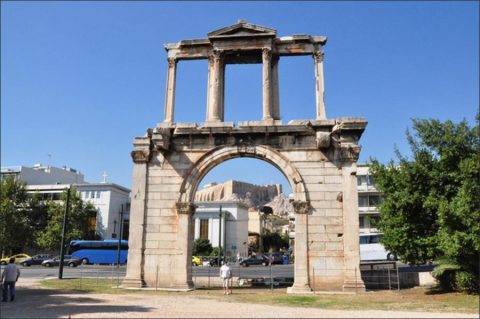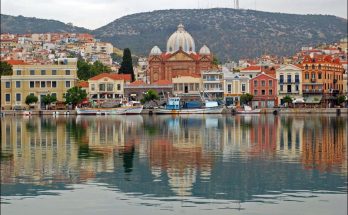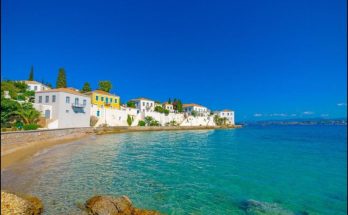
The dramas performed in the theatre at the feast of Dionysus were competitive. Each piece was produced at the expense of some public-spirited citizen who paid for the hire of the chorus and the staging of the play. This citizen was known as the choragus, and naturally he did his utmost to win the popular favour.
If his play were voted the best at that festival a prize was awarded in token of his victory, and he was allowed to set up a monument in the neighbourhood of the theatre bearing a bronze tripod in a conspicuous position. Much ingenuity was spent in devising different types of pedestal to hold the tripod. One contained a small statue by Praxiteles. The few remaining in place to-day show widely different types. In time the region round the theatre came to be filled with these so-called choragic monuments, and a street made through it was known as the “Street of Tripods.”
After the end of the fourth century B.C. it was no longer possible to find private patrons to finance the production of the plays and the State had to provide the funds. By this time the contests must have lost much of that eager and wholesome rivalry that called forth the best powers of playwright, chorus, and actors. These tripod monuments date therefore from the period when the drama was at its best.
At the end of a street opposite the Arch of Hadrian there is still a small graceful structure, looking like a tiny round tower. In Turkish times this was known as the “Lantern of Demosthenes,” owing to its supposed resemblance to a Turkish lantern. The origin of the supposed connection with Demosthenes is lost. An inscription on the architrave of the south-east side shows that in reality it was a monument erected by one Lysicrates in commemoration of his victory as choragus in one of the Dionysiac festivals which took place 334-3 B.C.

The size of the tripod has evidently determined the proportions of the whole building, which is made to carry the crowning feature as high as possible without allowing it to appear insignificant. The fluted Corinthian columns bearing the circular architrave and frieze seem naturally to suggest to the eye the slender horizontal lines of tripod with its shallow basin. One has only to imagine the tripod on the summit of the acanthus ornament that arises from the marble “thatch of laurel leaves” and at once there is a new satisfaction in the whole design. The acanthus ornament falls into place and the eye leaves off searching for an opening in the curved marble sides as the building changes from a dwarf temple into a fitting pedestal for the trophy.
We know from Pausanias that this building stood among many others, some of them containing masterpieces. It was therefore designed to hold its own by appropriateness and harmony rather than by any wealth of ornament. The tripods in low relief between the capitals and the frieze above are both strictly to the point. Dionysus is seated on a cliff, accompanied by his panther and attendant satyrs. He has encountered Tyrrhenian pirates who do not believe in his divinity and is changing them into dolphins. One of them may be seen leaping into the sea, already half a dolphin. Casts of this frieze are shown in the British Museum.
The building is of especial interest as the oldest example of Corinthian architecture extant. Standing in full view of the giant columns of the Olympieum the contrast reveals the range of the Corinthian order to which both belong.
About 1660 the “Lantern” was built into the walls of a Capuchin convent and reserved by the monks as a circular study attached to their guest-chamber. Here Byron, Dodwell, Galt, and other travellers stayed when they came to Athens. There was no proper inn in the town and the hospitality of the monks was freely offered.
In the rock of the Acropolis overlooking the Dionysiac Theatre there are two natural caves. The one immediately above the theatre was adapted as a choragic monument by a certain Thrasyllus ( 320 B.C.) who must have been a man of original ideas. He walled up the mouth of the cave and set three Doric pilasters on the face of the wall. These supported an architrave which probably carried the emblematic tripod.
An inscription recording the victory of Thrasyllus may be seen lying in front of the cave, though it is now broken. His son Thrasykles added two more inscriptions recording two more victories when he was president of the games fifty years later, and these also may be found lying near the spot. Either father or son crowned the edifice with the seated statue of Dionysus now in the British Museum. This monument of Thrasyllus was destroyed by the Turks when they besieged the Acropolis in 1826-7, but the spot is still conspicuous by reason of the two Corinthian columns which stand on the rock above the cave.
These were also put up to support tripods and are examples of the more commonplace type of choragic monument. They remain a standing perplexity to the casual sightseer. They suggest the remains of a temple, but the narrow ledge of rock on which they perch makes this out of the question. It is strange how many visitors fail to track them in the guide-books and come home saying, “But what are those two odd columns above the theatre?” The second cave is part of the great hospital-temple of Asklepios.
Visits: 203


